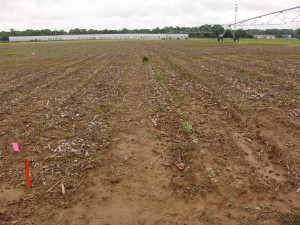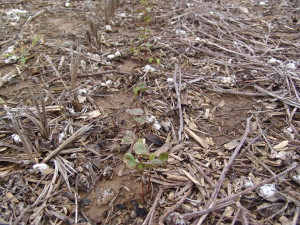It will not be surprising to hear reports on cotton burn from herbicide tankmixes over the next week or so for two reasons. First, with all the Glytol/Liberty Link as well as Roundup Xtend cotton planted this spring I expect more three way tankmixes of Liberty and Roundup plus Dual or Warrant. When all the surfactant from Liberty and Roundup is added to the oil of Dual or Warrant, burn on cotton is much more likely. The second reason is that the probability of seeing significant injury from these tankmixes increases greatly if the soil is wet and we appear to be guaranteed that for the next week.
We have run a couple studies last year and again this year to examine if the nozzle type used to apply these premixes could help mitigate the injury. The study was set up this year where a Roundup + Liberty+ Dual tank-mixture was applied with a TeeJet Flat Fan nozzle, a Wilger DR nozzle set on a 50% modulating cycle, a Greenleaf TADF Dual Fan nozzle and TeeJet TTI nozzle. The cotton had a 2nd leaf the size of a quarter at application timing.

Injury was greatest with the dual fan nozzle (35%) followed by the flat fan nozzle (23%), followed by the TTI (20%) and the DR nozzle (17%).
The results from the test this year would be consistent with what we saw last year where nozzles that produced a course droplet size or smaller (<400 micron) or increased coverage with dual fans showed the greatest amount of injury. In other words better coverage correlated to more surfactant burn injury to the cotton.

On the other hand, nozzles that produce a majority of very course droplet sizes (>400 microns) or larger did not cover the small cotton as well and resulted in less injury. A few examples of nozzles that provide very course or larger droplet sizes would be TeeJet AIXR, TeeJet AI, Greenleaf TDXL and the Wilger DR nozzles.
Steps to be taken to help avoid the surfactant burn injury from these post applications:
- If possible wait for soil to dry as wet soil can increase burn from Dual Magnum or Warrant due to the increase in humidity.
- Use single fan larger droplet size nozzles (AIXR, AI, TDXL, DR, etc) and reduce the gallons per acre to 10 or less. This decreases the coverage and lessons the area of the leaf that will be injured.
- Do not let the agitation shut down even for a few minutes and then start to spray. Dual and Warrant will readily settle out without agitation and the next acres will get a high rate the causing excessive burn.
- If the spray load sits overnight be sure to agitate load for 10 to 12 minutes then spray for several minutes on non-crop area before spraying field.
Will using the steps above cause Palmer amaranth control to suffer? The answer is yes, particularly in thick pigweed stands. However, less injury on the cotton this spring could help the cotton this fall from an earliness stand point. Moreover, Palmer amaranth escapes could be controlled with a followup Liberty application, cultivation or chopping crew.
Of course many of these applications go out tankmixed with an insecticide to control thrips. Scott Stewart and I have several years of research with acephate tankmixed with all of these combinations and have never found that adding that insecticide increases injury.
Finally with all the rain over the past couple of weeks there is a good bit of water stressed cotton. I would avoid adding Dual or Warrant tankmixed into Roundup or Liberty applications on this cotton. If at all practical, it would be better to give the cotton a week or so to recover before applying a residual Palmer amaranth herbicide.

